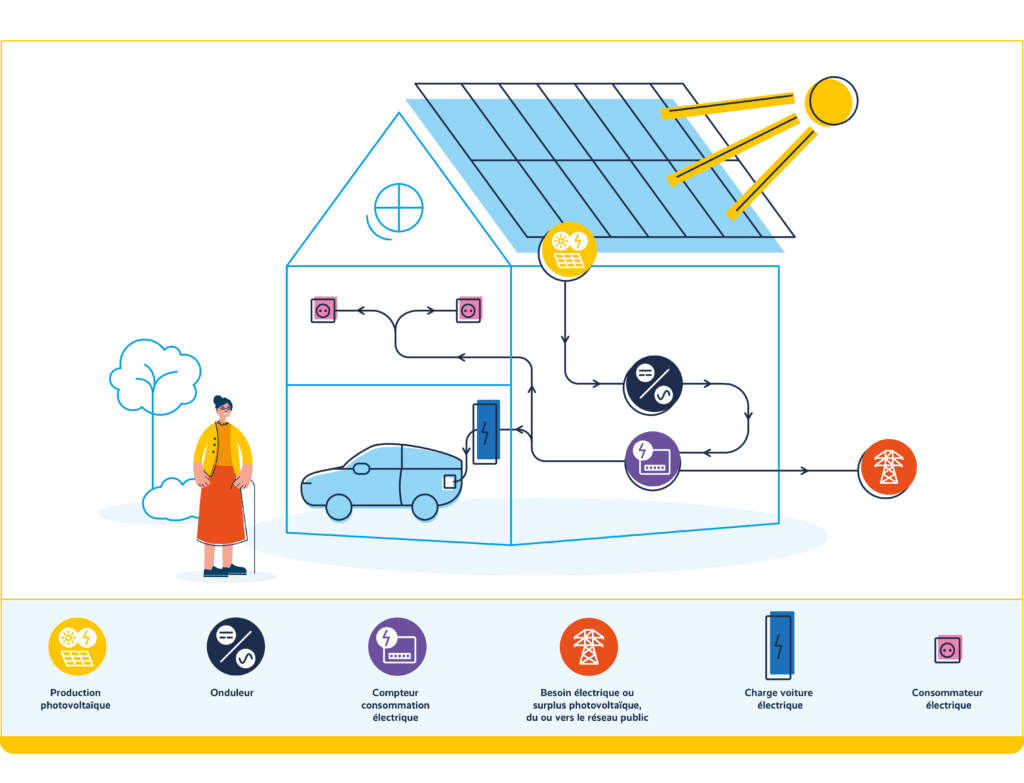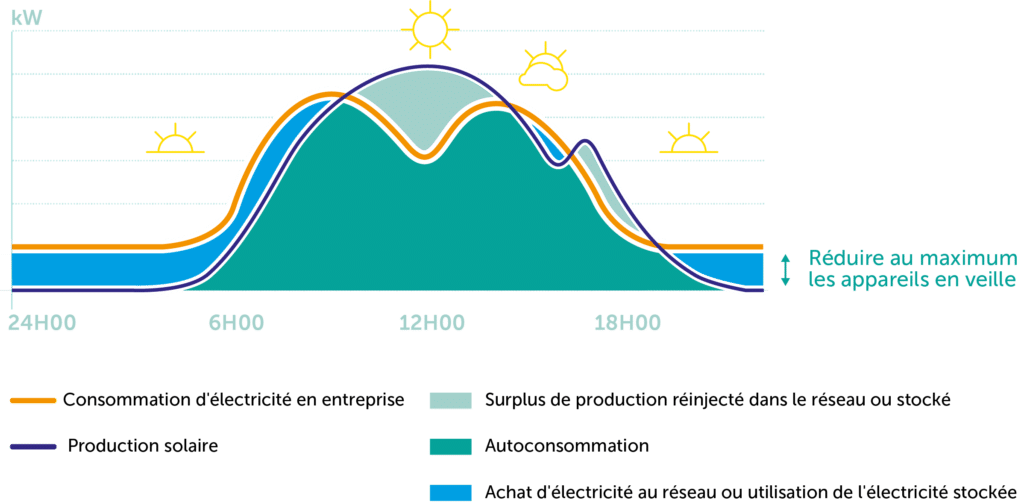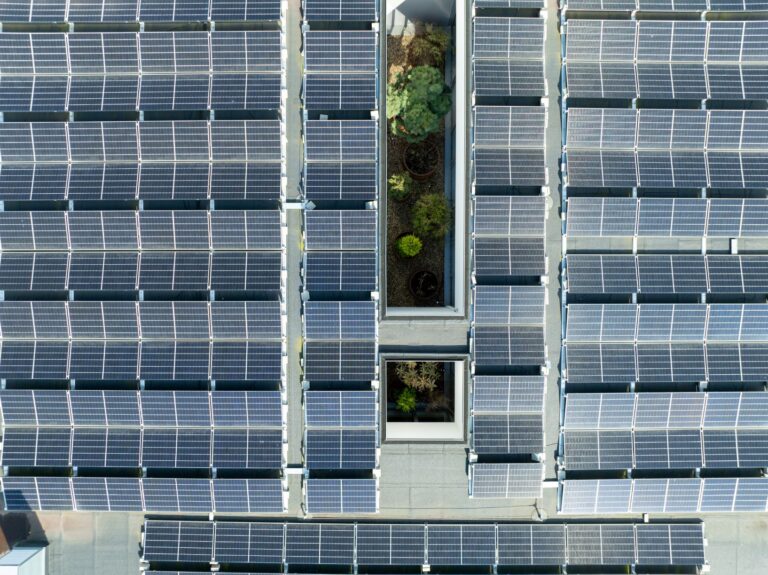To make this measure more effective and tailored to the specific context of your company, we recommend that you first perform an overall analysis of your energy situation.
Promoting self-consumption and electricity sharing within your company
Self-consumption refers to using the electricity that you generate on your own. This approach helps you become less reliant on the energy market and suppliers, insulating you from price fluctuations. For instance, by installing solar panels, you can produce renewable electricity that meets your company’s electrical needs, whether it’s for lighting, powering an EV-charging station, or running other appliances. Additionally, this self-produced energy can also be used to power larger systems like heat pumps.
The following article provides an overview of various self-consumption methods, highlighting their benefits and drawbacks, along with the necessary procedures, available subsidies, and relevant measures.
Technical specifications of self-consumption systems
Self-consumption refers to the direct use of electricity generated by the company itself. By opting for this approach, you can cover part of your electricity needs by producing your own renewable energy. Among renewable energy solutions, photovoltaics (electricity produced from solar energy) is currently the most accessible for most businesses. Self-consumption is therefore a key element in the energy transition.
The self-consumption rate represents the percentage of electricity that is produced and used directly on site. The goal is to maximise this rate by aligning energy consumption as closely as possible with energy production. To do this, it is crucial to adjust electricity consumption patterns to coincide with periods of production, aiming for simultaneity between the two. Intelligent demand-side management (DSM) systems can help optimize this process by identifying the most advantageous times to use energy. Additionally, installing storage batteries allows you to store photovoltaic energy for use during non-production hours.

Self-consumption should not be confused with self-sufficiency, which involves covering 100% of your electricity needs with your own production. Achieving self-sufficiency requires designing and sizing an installation capable of meeting all your electricity demands at all times. However, since most consumers remain connected to the electricity grid, pursuing self-sufficiency can be very costly and is often not a practical or necessary approach.
Definition of the requirements
If a company produces energy, it can also consume it. There are various ways of consuming or sharing your company’s production.
Analysing the potential for self-cosumption and electricity sharing
- What is the potential for harnessing solar energy?
- What is my company’s energy consumption profile and is there any potential for self-consumption? – Tool for comparing load curves and simulating sharing groups?
- Are there potential consumers outside the company who could participate in sharing the electricity (other company units, neighbours, etc.)?
The different types of self-consumption
Individual self-consumption
The electricity generated by a building is used directly by its occupants, making the energy producer and consumer the same entity. To maximize the self-consumption rate, it’s important to align energy use as closely as possible with production. If there is surplus electricity, it can either be fed into the grid or stored for later use—either in a solar battery or by powering equipment like a heat pump that charges a buffer tank. Any electricity fed into the grid is compensated at the wholesale market price for that month. During times when production is low or absent, you can draw on stored energy or rely on the electricity grid.
Collective self-consumption
Collective self-consumption means sharing the produced energy:
- within a condominium (several network users in the same building, behind a single connection point) ;
- between neighbours (maximum of three network users), where the distance between the two furthest injection or withdrawal points does not exceed 100 metres;
- or in the specific case of a network user with several supply points (e.g. an agricultural, craft or industrial establishment).
Collective self-consumption is only possible with a single low-voltage electricity grid operator. The first two cases are exempt from the grid usage tax for shared electricity, and the third case is only exempt if the maximum distance of 100 metres is respected.
The energy is shared based on an allocation scheme to be defined between the members of the sharing group. Agreements must be drawn up with the grid operator and between the members of the sharing group to set up this distribution.
Energy community
An energy community is possible in two scenarios
- the local energy community (sharing of renewable energy when the distance between the two furthest points of injection or withdrawal does not exceed 300 metres, and exemption from network use tax, a single electricity network operator and low voltage)
- the national energy community (without geographical restrictions, but without exemption from the grid usage tax).
By law, an energy community must be set up as a legal entity. With the exception of large companies, any private or legal entity, including public organisations, is eligible. All types of business are permitted. The production plants ( possibly at national level) can be joint or individual.

Implementation of the self-consumption system
Procedural steps
Individual self-consumption
- Simple request to the grid operator and signature of an agreement
- No technical adaptation of electrical installations required
- Sign a feed-in contract with an electricity supplier to take back any surplus electricity
Autoconsommation collective
- Establishment of a sharing group and agreement on the allocation scheme for the generated electricity
- Signature of an agreement with the grid operator
- Setting up a buy-back contract with a supplier to take back any surplus electricity
- Signing of an allocation agreement between the members of the sharing group, notably to define the price of the shared electricity and the terms of payment.
- For more information and related documents: klima-agence.lu
Energy community
- Establishment of a sharing group and agreement on the allocation scheme for the generated electricity
- Extending the scope of the business activities to include the energy community or setting up a seperate entity
- Notifying the ILR of the creation of the energy community
- Signature of an agreement with the grid operator
- Setting up a buy-back contract with a supplier to take back any surplus electricity
- Signing of an allocation agreement between the members of the sharing group, notably to define the price of the shared electricity and the terms of payment.
- The community can delegate the responsibility for organising the allocation to a service provider
- For more information and related documents: klima-agence.lu
Electricity allocation scheme
When you opt for a collective self-consumption system or an energy community, by default the electricity will be shared in proportion to the consumption of the various supply points. However, it is important to know that it is also possible to allocate electricity according to different preferences. The members of the community can also devise a more complex allocation scheme, by giving priority to certain consumers or by defining the allocation percentages themselves.
Practical information on sharing electricity
- An energy report (quarter-hourly detail) is drawn up by the network operator, according to the chosen allocation scheme. This report is sent monthly to the self-consumers/sharing group representative.
- Participation in collective self-consumption or in an energy community is voluntary.
- Each member of an energy community can sign individual electricity supply contracts with suppliers of their choice.
Subsidy application
Call for tenders for investment subsidies for large-scale photovoltaic power plants
In principle, investment subsidy encourages companies to produce all or part of their own energy through the granting of a subsidy paid at the time the photovoltaic plant is commissioned.
This 4th call for tenders comprises 3 lots. For each lot, sublots dedicated to photovoltaic installations with battery storage are now included. The maximum subsidy amounts range from €395/kWp to €1,100/kWp for installations without electricity storage, and from €515/kWp to €1,280/kWp for installations with storage. The total budget for this call for tenders is €17 million.
The subsidy is awarded through a project call. This is a competitive process: projects requesting the lowest subsidy relative to installed capacity are selected, within the available budget.
| Deadline: 17 October 2025 (12:00 CET) Practical details can be found at guichet.lu. For questions: appel.pv@eco.etat.lu |
FAQ
What is meant by the notion of a site?
In the context of the electrical system, a site1 consists of contiguous parcels on which all network users are electrically connected to each other through the same electrical installation, located downstream of the same connection point. Thus, electricity produced on a site and consumed at the same time on that same site does not pass through the public network.
1 a national, regional, or municipal economic activity zone is not considered a single site.
What is an energy community?
An energy community is a legal entity whose statutes specify that its main objective is to offer environmental, economic, or social community benefits to its members, shareholders, or the local areas where it operates, rather than generating financial profits. An energy community is authorized, among other things, to organize the sharing of electrical energy produced by generation units, which the community or its members/shareholders own or have made available to the community through a leasing contract, without prejudice to network access fees, usage fees, and other charges, levies, and taxes applicable to each member of the community. This sharing can be organized into one or more sharing groups. In general, an energy community is used by its members or shareholders as a vehicle to jointly participate in the energy sector. The majority of existing energy communities are structured as cooperative companies or non-profit associations. Communities are required to notify the regulator of their creation and dissolution.
It should be noted that large companies cannot be shareholders or members of an energy community.
What are the obligations of a supplier?
The role of a supplier is specifically regulated by the amended law of August 1, 2007, concerning the organization of the electricity market. This role involves several obligations, which also apply to an actor who chooses to become a supplier, in order to sell electricity produced on the same site to an end customer through a power purchase agreement. The main implications of this role are as follows:
- Every electricity supplier is an obligated party under the energy efficiency obligation mechanism2. This obligation to promote energy-saving projects is based on the supplier’s market share. The quantities sold on the same site are not considered in determining the supplier’s market share;
- If a supplier provides electricity to residential customers, they are required to offer standardized, published, and non-discriminatory products to all residential customers and must apply a number of consumer protection rules, including transparent billing;
- Every supplier is required to bill the amount of electricity consumed by the customer according to specific conditions outlined by law;
- Every supplier is required to provide certain data to the ILR (Institute of Regulation) for statistical purposes.
2 established by article 48bis of the amended law of August 1, 2007 on the organization of the electricity market (article 48bis de la loi modifiée du 1er août 2007 relative à l’organisation du marché de l’électricité)
What is considered a large company?
A company that employs more than 250 employees, or whose annual turnover exceeds 50 million euros, or whose total annual balance sheet exceeds 43 million euros.
